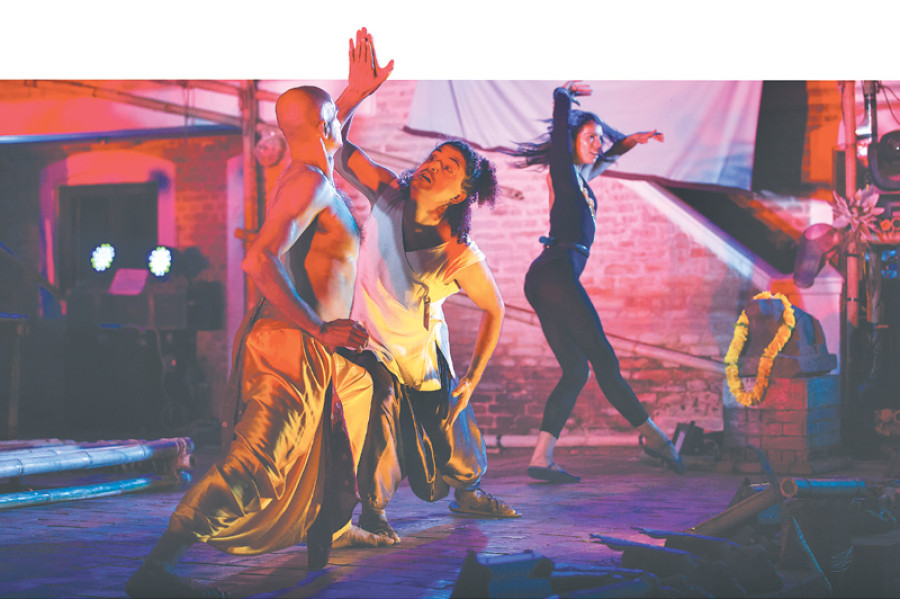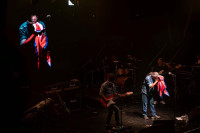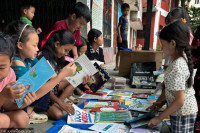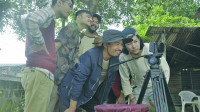Entertainment
Touching the sublime
Arjuna’s Dilemma is about one significant moment in The Mahabharata transformed into a comprehensive experience of dissonance, ending in resolution and harmony
Kurchi Dasgupta
In a way, history was made last week: the opera came to Nepal. Structured along a modern, Western musical tradition, Arjuna’s Dilemma opened at the Patan Museum’s Bhitri Chowk on Sep 2, Friday. It will continue to play till September 11 with a short break in the middle. It is not often that we get to witness such a spectacular vision involving music, visuals and performance and One World Theatre deserves to be thanked for taking on the challenge of bringing such a production to Nepal, one that charts new territory for the arts.
Arjuna’s Dilemma exploits its chamber opera format optimally by playing out on the smallish, open air stage in the inner courtyard of the Patan Museum and is accompanied by an ensemble orchestra of just nine musicians, including the music director, Jonathan Khuner, on the piano. Even the acoustics is very different from what you would expect in a full-sized opera hall. Created by Douglas J Cuomo (of Doubt fame) with the specific intention of exploring the connections between Western and Eastern musical idioms and philosophical nodes, Arjuna’s Dilemma adapts itself well to a Nepali ensemble comprising the cast, key singers and musicians.
Deborah Merola (Founder -Director of One World Theatre), as the stage director, has contoured the performance part well through Salil Subedi’s Arjuna and Rajkumar Pudasaini’s Krishna. They were ably supported by Aruna Karki, Srijana Adhikari, Shanti Giri and Pashupati Rai as the female ensemble and Utpal Jha, Hemanta Chalise, Amrit Dahal and Hum BC as the male ensemble. Alize Biannicis exceptionally agile as always, in her personification of Gandiva or the bow of Arjuna. But it was Roy Stevens and Annalisa Winberg’s singing on stage, as they alternated between Arjuna’s and Krishna’s voices, which brought the production’s unique operatic elements to the fore. Both Stevens and Winberg belted out impressive solos on stage in Sanskrit, Hindi and English formally set to operatic vocal structures.
Hearing familiar Sanskrit verses in Steven’s tenor (he usually sings in baritone otherwise) was an experience indeed, and somewhat unsettling for its defamiliarising effect. Interestingly, they both sang alternately for often the same character and the variations in mood, thanks to the shifts from soprano to tenor or vice versa, added unexpected aural depth. As did Gurudev Kamat, who lent his voice beautifully to both Arjuna and Krishna through hymns and bhajans sung in the Hindustani classical tradition.
Arjuna’s Dilemma revolves round a miniscule but very significant part of The Mahabharata, the few minutes during which Arjuna lays down his Gandiva and refuses to go to war with his family and kin, friends and followers fighting on the Kaurava side. It was then up to Krishna, Vishnu incarnate during the Dwapar era apart from being Arjuna’s dearest friend and charioteer, to cut through the illusion or maya of existence and convince Arjuna of the inevitability of mortality and the demands of Time in the greater scale of things. We know what we are talking about here, The Bhagavad Gita of course. And Arjuna’s Dilemma reaches its performative and musical crescendo during the revelation of Krishna, when the mere charioteer transforms himself onstage into Vishnu, the protector of the universe. Rajkumar Pudasiani’s graceful transitions between iconographic manifestations of fearsome destructor and benevolent friend were a joy to witness, ably supported as he was by the ensemble and the solo singers. The playful pastiche of kathak, Nepali folk and Bollywood freestyle was extremely entertaining. Salil Subedi portrays Arjuna’s ‘dilemma’ to perfection, his histrionic abilities allowing him equal stature to Krishna’s grandeur. However, what I found perhaps most moving was the undercurrent of friendship between the two. For despite the differences between a great warrior and Vishnu incarnate, it was primarily a deep friendship that held the two together over the length of their lives on Earth. Both Subedi and Pudasaini reinforced that friendship through their bodily gestures while Stevens and Annalisa’s singing highlight the unbridgeable gap between the mortal and the divine.
The music written by Douglas J Cuomo is extraordinary. I have yet to come across a better amalgamation of Western and Eastern musical traditions that incorporate both vocals and instrumentals. The music flowed between classical Western and classical Hindustani, via the beat of jazz. It apparently took Cuomo nearly eight years to finalise the opera and his exquisite attention to detail comes through at every turn as the music glided across brief stretches of symphonic, pastoral peace to flow into Byzantine and Gregorian chants, to suddenly come up against obsessive, staccato repetitions like ‘stop my chariot, chariot, chariot!’ and the hymnal ‘O Krishna’. And then it fluidly moves into popular bhajans and glorious arias with equal ease, all woven together through the syncopatic ‘off’ beat of jazz. Arjuna’s Dilemma is essentially an American, modern piece and its flavour is unequivocally ‘jazz’ that gets highlighted through recurring percussion beats and saxophone pieces. In fact, Inap Shrestha comes on stage with his saxophone at a crucial moment to deliver a moving solo piece. On the other hand, Jagannath Dhaugoda holds up the Hindustani percussion tradition with panache. Both Gurudev Kamat and Rhythm Kandel are exceptionally proficient in their performances of Hindustani classical vocals—a difficult feat no doubt as they had to match their scales to the overarching Western classical and jazz tonality. The chorus sung by Lucia de Vries, Sabine Piccard, Rose Scwietz, Abby Buckland, Nadine Rogers, Naomi Saville and often led by Annalisa Winberg herself, was an extraordinary experience in itself as they created and held the mood at every single moment. And though I am no music aficionado but I believe that without the presence of Jonathan Khuner’s overall guidance, Arjuna’s Dilemma would not have been the magnificent show it is. It was his magic wand (the conductor’s!) that held all these disparate musical elements and modes together to create the sublime joy we experienced at Patan Museum that evening. His brilliant piano deliveries were aptly supported by Albertina Barcelo on the flute, Madhu Sudan Bagdas on the clarinet, Mark Don Rani on percussion, Roman Budhathoki and Rabindra Maharjan on violins, Manik Raz Maharjan on Viola and Sanjay Shrestha on cello.
Greg Mitchell has presented us with an edgy, organic, multi-tiered set crafted from locally harvested bamboos by the graduating students of Kathmandu University’s art and design programme and was led by Utsab Maharjan. Current students from the same program created a host of artworks specifically for the opera under Mitchell’s guidance and these hold pride of place on the set, introducing unexpected visual surprises alongside props made by Sajan Thapa Magar. The operatic tradition has always leaned heavily towards the overwhelmingly spectacular and Mitchell’s contemporary set design, when supplemented by his luminescent lighting, held up the music and gave direction to the narrative while transporting us to a supra-real space. His costume designs were exquisitely materialised by Kalsang Lama. Lucy Peckham’s sound engineering brought the music to us and a host of people like Isu Shrestha, Kavita Srinivasan, Carolina Stevens, Ragendra Nath Shrestha, Atul Bhattarai and others must have laboured tirelessly to have made this extraordinary experience possible on a stage in Nepal, especially in a year following hard on the heels of the disastrous last.
Arjuna’s Dilemma is about one significant moment in The Mahabharata but in true operatic tradition that moment was transformed by Douglas Cuomo into a comprehensive experience of dissonance, ending in resolution and harmony. In a world wracked by war and terror, it is easy to misinterpret Krishna’s rousing call to Arjuna. But the opera’s libretto and music make us take a closer look at the deep structures that define our experiences and puts us in brief touch with the sublime if only for 70 minutes, but long enough for us to brace up and strive towards harmony in our own realities.
Dasgupta is an artist and writer based in Kathmandu




 16.12°C Kathmandu
16.12°C Kathmandu










